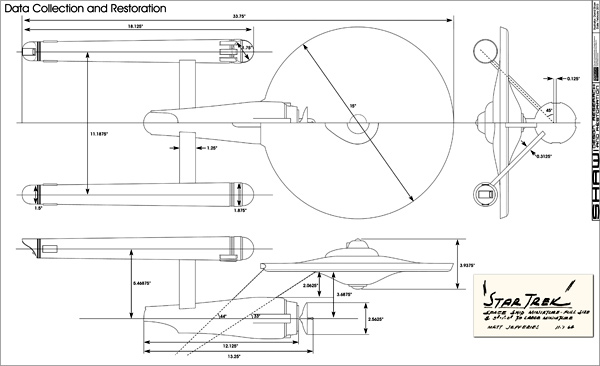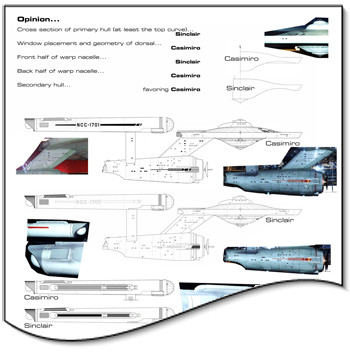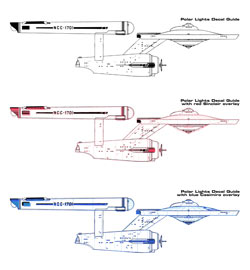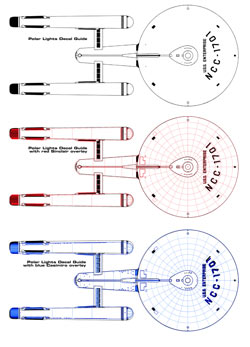-
Welcome! The TrekBBS is the number one place to chat about Star Trek with like-minded fans.
If you are not already a member then please register an account and join in the discussion!
You are using an out of date browser. It may not display this or other websites correctly.
You should upgrade or use an alternative browser.
You should upgrade or use an alternative browser.
Which Original Series Enterprise Orthographic Drawings Are Considered the Most Accurate?
- Thread starter Irishman
- Start date
The most accurate TOS-E blueprints publicly available are the decal placement guides from the Polar Lights 1:1000 kit. These are based on Gary Kerr's plans and, while some of the smaller details are omitted due to the small scale of the model, the shape and proportions are quite accurate. A particular boon is that the downloadable instruction PDF lets you access them as vector art in Illustrator or (maybe) Inkscape. Here's a link:
http://round2models.com/files/instructions/pol803.pdf
Consult the other BPs you listed for some of the finer details.
M.
http://round2models.com/files/instructions/pol803.pdf
Consult the other BPs you listed for some of the finer details.
M.
Great find, MGagen! That will be a great help to me.
I recently re-upped my membership over at hobby talk, and am catching up on your contributions to the TOS Enterprise threads. It's been ten years since I was there, pm'ing with Robert Bonchune, back when he was dumping renders of ships from ST: Enterprise. Good times.
Thanks again.
I recently re-upped my membership over at hobby talk, and am catching up on your contributions to the TOS Enterprise threads. It's been ten years since I was there, pm'ing with Robert Bonchune, back when he was dumping renders of ships from ST: Enterprise. Good times.
Thanks again.

Very cool, I never thought to look at those instructions for blueprints!
I used the Casmiro designs when I built my 3D model, but it's been a while.
-Ricky
I used the Casmiro designs when I built my 3D model, but it's been a while.

-Ricky
It's been about three years(?) since I was booted from Hobbytalk for something I still think was truly stupid.
Sometimes I miss participating there, but I don't miss the constipated attitudes of some of the posters and mods.
That's horrible! You are a great artist.
I recently re-upped my membership over at hobby talk, and am catching up on your contributions to the TOS Enterprise threads. It's been ten years since I was there,
I am nowhere near as active on the boards (HobbyTalk, here or anywhere) as I once was, but I still check in from time to time. I'm pleased my contributions are still remembered kindly.
I'm also glad you've joined up again. So many folks have been banned, some for justifiable reasons, some not (I'm referring to you, Warped9), that I have lost track of many folks.
This is where I'll start when I get around to modeling my take on the Pike era Enterprise.The most accurate TOS-E blueprints publicly available are the decal placement guides from the Polar Lights 1:1000 kit. These are based on Gary Kerr's plans and, while some of the smaller details are omitted due to the small scale of the model, the shape and proportions are quite accurate. A particular boon is that the downloadable instruction PDF lets you access them as vector art in Illustrator or (maybe) Inkscape. Here's a link:
http://round2models.com/files/instructions/pol803.pdf
Consult the other BPs you listed for some of the finer details.
M.
Thanks for sharing! Fantastic art!The most accurate TOS-E blueprints publicly available are the decal placement guides from the Polar Lights 1:1000 kit. These are based on Gary Kerr's plans and, while some of the smaller details are omitted due to the small scale of the model, the shape and proportions are quite accurate. A particular boon is that the downloadable instruction PDF lets you access them as vector art in Illustrator or (maybe) Inkscape. Here's a link:
http://round2models.com/files/instructions/pol803.pdf
Consult the other BPs you listed for some of the finer details.
M.
Mine, of course!Is it Casmiro?
Is it Sinclair?
Is it Shaw?
Is it someone else?
And, most of all, why?
Just kidding.

If we're talking about the 11 foot model, my plans aren't finished and also differ from other plans in that mine are an attempt to document the model as a model rather than the idealized starship. But anyone is welcome to my current progress...
Study sketch 001
Study sketch 002
Study sketch 003
Study sketch 004
Study sketch 005
Study sketch 006
Study sketch 007
Including my work on Jefferies original plans (which are now painfully dated with the release of Datin's daughter's book)...Study sketch 002
Study sketch 003
Study sketch 004
Study sketch 005
Study sketch 006
Study sketch 007
... but I'm working on updating them currently.
Given the incomplete nature of my current work, we can look at Casimiro's and Sinclair's plans. I did a quick comparison of their plans 9 years ago...
But I know Casimiro has made updates since then, and is still working on his plans (which I would consider a plus). As to how their plans compare to the decal sheet...
At this point, I haven't looked at them in a long time. Looking at other people's plans means I might not see details as they actually are on the real model because I'm expecting to see those details as they were in someone else's plans.
A great example of this is my plans for the studio model of the Galileo (which were done along with a one-half studio scale study model). A lot of people don't notice the missing "-" from the large registry number. But when recreating the decals (all hand drawn rather than using pre-existing fonts), that becomes something that is hard to miss (Kerr included the "-" on his drawings of the Galileo studio model, and he usually doesn't miss details).
But my recommendation would be to use them all. Compare and contrast them against the studio model to see which features of each set match the best. Print out both sets, sit down with a hi-lighter and start browsing photos of the studio model.
It's the Enterprise after all, what could be more fun than looking at photos of her!

In looking into my notes on the PL decal plans, I recall two areas where they aren't quite right:
1. The lower part of the primary hull is too shallow by a tiny bit, amounting to about half of the thickness of the outer ring of the lower sensor platform. This was discovered between the making of the 1:1000 model and the 1:350 model. The larger model is correct. You can fix the decal blueprint by dropping the sensor assembly by the mentioned amount and rotating the underside profile to meet it on an axis at the outer edge of the underside of the hull. Clear as mud?
2. Due to the small size of the model kit, the bridge dome profile is simplified from a more complex curve into a simple spherical section in the blueprint. Follow Sinclair, here, for a more accurate shape.
Even with these minor flaws, the decal guide is still excellent, and is the only publicly available BP that is based on direct examination of the studio model.
Sinclair's BPs are a close second for accuracy; I have always loved Casmiro's artistic presentation in his BPs (I am delighted to hear he is revising them); and Shaw's plans look to be shaping up very nicely (as is expected from so thorough a workman).
M.
1. The lower part of the primary hull is too shallow by a tiny bit, amounting to about half of the thickness of the outer ring of the lower sensor platform. This was discovered between the making of the 1:1000 model and the 1:350 model. The larger model is correct. You can fix the decal blueprint by dropping the sensor assembly by the mentioned amount and rotating the underside profile to meet it on an axis at the outer edge of the underside of the hull. Clear as mud?
2. Due to the small size of the model kit, the bridge dome profile is simplified from a more complex curve into a simple spherical section in the blueprint. Follow Sinclair, here, for a more accurate shape.
Even with these minor flaws, the decal guide is still excellent, and is the only publicly available BP that is based on direct examination of the studio model.
Sinclair's BPs are a close second for accuracy; I have always loved Casmiro's artistic presentation in his BPs (I am delighted to hear he is revising them); and Shaw's plans look to be shaping up very nicely (as is expected from so thorough a workman).
M.
And I used Sinclair's, and it's been a LONG whileI used the Casmiro designs when I built my 3D model, but it's been a while.
 . But 11 years ago (!) the Shaw and MGagen blueprints weren't available, so that was that.
. But 11 years ago (!) the Shaw and MGagen blueprints weren't available, so that was that.Similar threads
- Replies
- 3
- Views
- 318
- Replies
- 0
- Views
- 111
- Replies
- 41
- Views
- 3K
If you are not already a member then please register an account and join in the discussion!




